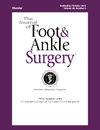Effects of kinesio taping versus extracorporeal shock wave therapy on pain in the treatment of plantar heel pain secondary to plantar fasciitis and a calcaneal spur: A retrospective clinical trial
IF 1.3
4区 医学
Q2 Medicine
引用次数: 0
Abstract
Plantar heel pain is a common musculoskeletal problem in adults that causes limitation and disability in daily life activities. This study aimed to compare the effects of extracorporeal shock wave therapy(ESWT) and kinesio taping(KT) treatments on pain, functionality and quality of life in the treatment of plantar heel pain secondary to plantar fasciitis and a calcaneal spur. Patients who received ESWT or KT treatment for plantar heel pain between September 2023 and February 2024 were retrospectively screened. Before treatment and at the third month after treatment, pain levels were evaluated with Visual Analog Scale (VAS), sensitivity with Heel Tenderness Index (HTI), functional status with Foot Function Index (FFI) and quality of life with the 12-item short form health survey(SF-12).A total of 60 patients were included in the study,32 patients in the ESWT group and 28 patients in the KT group. There was no significant difference between the groups in terms of age, gender, VAS value, HTI level, FFI value and SF-12 physical component score (PCS) before treatment. There was a significant improvement in VAS, HTI, FFI, and SF-12 PCS evaluations after treatment in both groups compared to the baseline. Furthermore, while both treatment methods resulted in a regression in VAS levels and improvement in FFI scores, the KT group demonstrated significantly better outcomes than the ESWT group. There was no significant difference in improvement in SF-12 PCS scores between the two groups. Our study indicates KT may be more effective than ESWT for treating plantar heel pain in terms of pain and functionality, but both treatment modalities have similar effects on quality of life.
运动贴与体外冲击波治疗对足底筋膜炎和跟骨刺继发足底后跟疼痛的影响:一项回顾性临床试验。
足底后跟疼痛是成年人常见的肌肉骨骼问题,会导致日常生活活动的限制和残疾。本研究旨在比较体外冲击波疗法(ESWT)和运动贴贴(KT)治疗足底筋膜炎和跟骨刺继发足底后跟疼痛对疼痛、功能和生活质量的影响。回顾性筛选2023年9月至2024年2月期间接受ESWT或KT治疗足底跟痛的患者。治疗前和治疗后第3个月,用视觉模拟量表(VAS)评估疼痛水平,用后跟压痛指数(HTI)评估敏感性,用足部功能指数(FFI)评估功能状态,用12项简短健康调查(SF-12)评估生活质量。研究共纳入60例患者,其中ESWT组32例,KT组28例。两组患者治疗前年龄、性别、VAS值、HTI值、FFI值、SF-12生理成分评分(PCS)差异均无统计学意义。治疗后两组患者的VAS、HTI、FFI和sf - 12pcs评分均较基线有显著改善。此外,虽然两种治疗方法都导致VAS水平的回归和FFI评分的改善,但KT组的结果明显优于ESWT组。两组sf - 12pcs评分改善无显著差异。我们的研究表明,就疼痛和功能而言,KT可能比ESWT更有效地治疗足底跟痛,但两种治疗方式对生活质量的影响相似。证据等级:三级。
本文章由计算机程序翻译,如有差异,请以英文原文为准。
求助全文
约1分钟内获得全文
求助全文
来源期刊

Journal of Foot & Ankle Surgery
ORTHOPEDICS-SURGERY
CiteScore
2.30
自引率
7.70%
发文量
234
审稿时长
29.8 weeks
期刊介绍:
The Journal of Foot & Ankle Surgery is the leading source for original, clinically-focused articles on the surgical and medical management of the foot and ankle. Each bi-monthly, peer-reviewed issue addresses relevant topics to the profession, such as: adult reconstruction of the forefoot; adult reconstruction of the hindfoot and ankle; diabetes; medicine/rheumatology; pediatrics; research; sports medicine; trauma; and tumors.
 求助内容:
求助内容: 应助结果提醒方式:
应助结果提醒方式:


